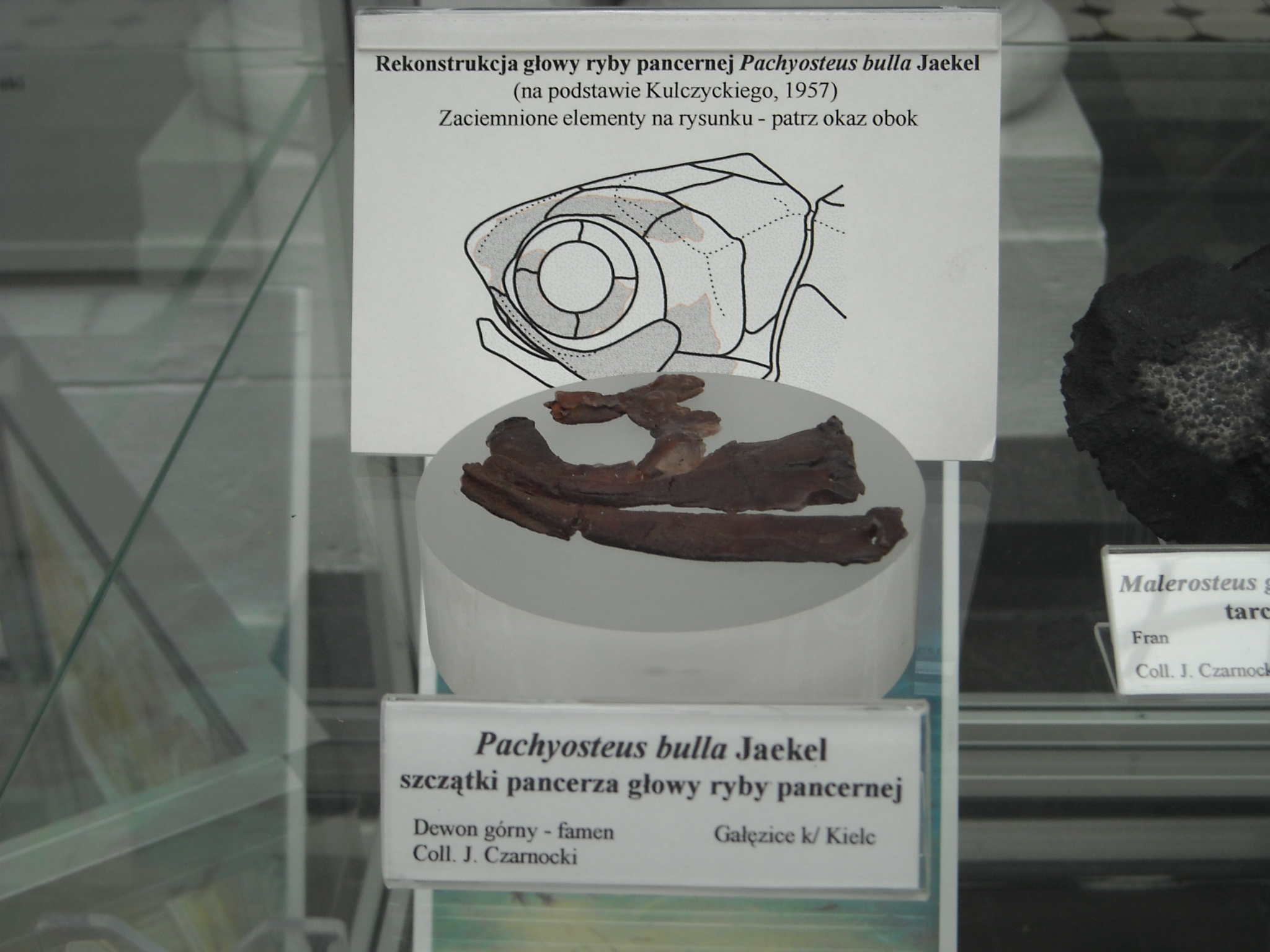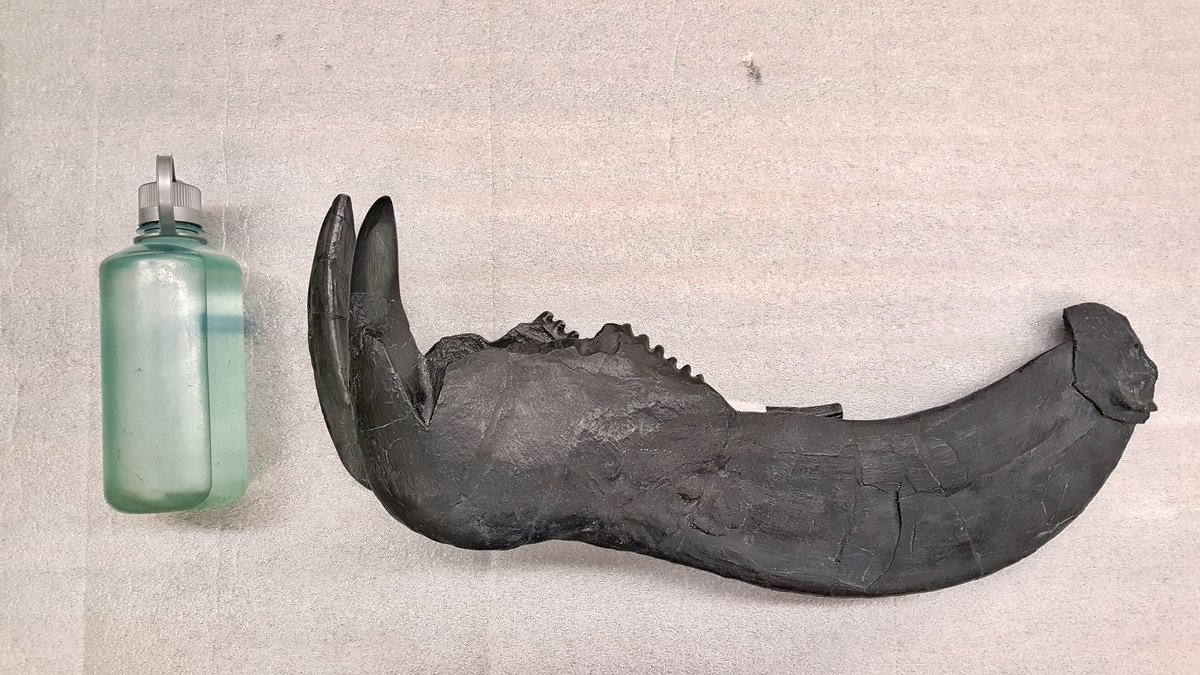|
Selenosteidae
Selenosteidae is an extinct family of small to large-sized arthrodire placoderms from the Late Devonian. With the exception of the Chinese '' Phymosteus'', selenosteids lived in shallow seas in what is now Eastern North America (the Cleveland Shale), Eastern Europe (Holy Cross Mountains, Poland, and the Kellwasserkalk fauna of Bad Wildungen), and Northeastern Africa (the Anti-Atlas Mountains, Morocco). Selenosteids have, in cross section, a rounded body, a blunt snout, and tremendous orbits. The lower jaws were slender, the inferognathals usually either being finely serrated, or adapted for crushing, though, in '' Draconichthys'', the inferognathals had long prongs for seizing prey. The rostrum is very small. Taxonomy Selenosteidae is a member of the clade Aspinothoracidi, which belongs to the clade Pachyosteomorphi, one of the two major clades within Eubrachythoraci. ''Gorgonichthys'' is closely related to the family Selenosteidae, and could possibly be included in the f ... [...More Info...] [...Related Items...] OR: [Wikipedia] [Google] [Baidu] |
Amazichthys
''Amazichthys'' is an Extinction, extinct genus of Selenosteidae, selenosteid Arthrodira, arthrodire from the Famennian, Middle Famennian of the Late Devonian of the Anti-Atlas, Anti-Atlas Mountains of Morocco. It contains a single species, ''Amazichthys trinajsticae''. It is one of a few example of Placodermi, placoderm known from whole body shape, including cartilaginous axial and fin elements. Description ''Amazichthys'' had a profile similar to that of fast-moving Pelagic fish, pelagic fishes, with lateral keels for stability, and a Caudal fin, lunate caudal fin, suggesting it could reach and maintain high speed. The holotype, AA.MEM.DS.8, is long. Etymology ''Amazichthys trinajsticae'' was named after the North African ethnic group Amazigh (Berbers), and Australian palaeontologist Kate Trinajstic. Taxonomy ''Amazichthys'' is part of Selenosteidae, a family inside the clade Aspinothoracidi, inside of Pachyosteomorphi, along with Dunkleosteoidea. The cladogram show ... [...More Info...] [...Related Items...] OR: [Wikipedia] [Google] [Baidu] |
Melanosteus
''Melanomontanosteus'' is an extinct genus of selenosteid placoderm that lived during the Late Devonian. It contains one valid species, ''M. occitanus'', known from fossils found in Southern France. Taxonomy ''Melanosteus occitanus'' was named by Hervé Lelièvre and Daniel Goujet in 1987 for a specimen from Montagne Noire consisting of the jaws and the cranial and thoracic armor. However, that genus name was preoccupied by the melanosclerite ''Melanosteus''. In 2023, Artem M. Prokofiev proposed ''Melanomontanosteus'' as a replacement name. Phylogeny ''Melanomontanosteus'' has been classified as a member of the family Selenosteidae since its original description. Below is a simplified cladogram A cladogram (from Greek language, Greek ''clados'' "branch" and ''gramma'' "character") is a diagram used in cladistics to show relations among organisms. A cladogram is not, however, an Phylogenetic tree, evolutionary tree because it does not s ... based on the results of Jobbins ... [...More Info...] [...Related Items...] OR: [Wikipedia] [Google] [Baidu] |
Pachyosteus
''Pachyosteus'' is an extinct monospecific genus of medium-sized selenosteid arthrodire placoderm known from the Upper Frasnian Kellwasserkalk facies of Late Devonian Bad Wildungen, Germany and from the Famennian portions of the Holy Cross Mountains of Poland. The type species ''Pachyosteus bulla'' has a broad skull about long, a comparatively long median dorsal plate, and a short rostral plate that meets the pineal plate. Phylogeny ''Pachyosteus'' is a member of the family Selenosteidae of the clade Aspinothoracidi, which belongs to the clade Pachyosteomorphi, one of the two major clades within Eubrachythoraci. The cladogram below shows the phylogeny of ''Pachyosteus'': In his cladogram, Rücklin (2011) regards ''Pachyosteus bulla'' as a basal selenosteid, being the sister taxon of the American genera, and the Kellwasserkalk genera of Germany and Morocco Morocco, officially the Kingdom of Morocco, is a country in the Maghreb region of North Africa. It has coastline ... [...More Info...] [...Related Items...] OR: [Wikipedia] [Google] [Baidu] |
Rhinosteus
''Rhinosteus'' is an extinct genus of small to medium selenosteid arthrodire placoderms of the Late Devonian known from the Upper Frasnian Kellwasserkalk facies of Bad Wildungen, Germany and Morocco. Description ''Rhinosteus'' is a typical genus of Kellwasserkalk selenosteids, with short cheeks, and slender inferognathal (lower jaw) plates. However, two of the species, ''R. traquairi'' and ''R. tuberculatus'', have long, pointed rostrums, and tubercles on the plates. In ''R. traquairi'', the rostrum is sharply pointed, extending beyond the snout, and the tubercles are small and irregularly placed. In ''R. tuberculatus'', the rostrum is bluntly pointed, and the tubercles are large and plentiful. The species ''R. parvulus'' has a blunt rostrum that does not extend beyond the snout, and lacks tuberculation altogether. The average skull length of ''R. traquairi'' is about 11 centimetres. The average skull length of ''R. tuberculatus'' is 15 centimetres, while that of ''R. parvulus'' ... [...More Info...] [...Related Items...] OR: [Wikipedia] [Google] [Baidu] |
Stenosteus
''Stenosteus'' is an extinct monospecific genus of medium-sized selenosteid arthrodire placoderms of the Late Devonian period known from the Upper Famennian Cleveland Shale of Ohio. Estimated skull lengths range from 6 to 9 centimeters Most fossils of ''Stenosteus'' have been scraps of armor and portions of tooth-plates suggestive of '' Selenosteus''. In 1996, enough material of a new species, ''S. angustopectus'', was recovered to allow a reconstruction of armor that resembles that of ''Selenosteus''. Phylogeny ''Stenosteus'' is a member of the family Selenosteidae of the clade Aspinothoracidi, which belongs to the clade Pachyosteomorphi, one of the two major clades within Eubrachythoraci. The cladogram below shows the phylogeny A phylogenetic tree or phylogeny is a graphical representation which shows the evolutionary history between a set of species or Taxon, taxa during a specific time.Felsenstein J. (2004). ''Inferring Phylogenies'' Sinauer Associates: Sunderland, M ... ... [...More Info...] [...Related Items...] OR: [Wikipedia] [Google] [Baidu] |
Brachyosteus
''Brachyosteus'' is an extinct genus of arthrodire placoderm from the Late Frasnian stage of the Late Devonian period. Fossils are found from Bad Wildungen, Germany. Phylogeny ''Brachyosteus'' is a member of the family Selenosteidae of the clade Aspinothoracidi, which belongs to the clade Pachyosteomorphi, one of the two major clades within Eubrachythoraci. The cladogram below shows the phylogeny A phylogenetic tree or phylogeny is a graphical representation which shows the evolutionary history between a set of species or Taxon, taxa during a specific time.Felsenstein J. (2004). ''Inferring Phylogenies'' Sinauer Associates: Sunderland, M ... of ''Brachyosteus'': References Selenosteidae Placoderm genera {{Placoderm-stub ... [...More Info...] [...Related Items...] OR: [Wikipedia] [Google] [Baidu] |
Gorgonichthys
''Gorgonichthys'' is extinct monospecific genus of large arthrodire placoderm. Fossils are found in the Upper Famennian Cleveland Shales of Late Devonian in Ohio. The type species is ''Gorgonichthys clarki''. Description ''Gorgonichthys'' had sharp, pointed edges on the dental plates of the upper and lower jaws. With a headshield length of up to , it is estimated to have been comparable to the size of ''Dunkleosteus''. Phylogeny ''Gorgonichthys'' is a member of the clade Aspinothoracidi, which belongs to the clade Pachyosteomorphi, one of the two major clades within Eubrachythoraci. It is closely related to the family Selenosteidae, and could possibly be included in that family. The cladogram below shows the phylogeny of ''Gorgonichthys'': According to a 2022 Jobbins ''et al.'' study, ''Gorgonichthys'' was found to be more related to '' Heintzichthys'' than '' Gymnotrachelus'', potentially making ''Gorgonichthys'' a member of Selenosteidae Selenosteidae is an extinct fami ... [...More Info...] [...Related Items...] OR: [Wikipedia] [Google] [Baidu] |
Gymnotrachelus
''Gymnotrachelus'' is an extinct monospecific genus of large selenosteid arthrodire placoderm of the Late Devonian known from the Late Famennian Cleveland Shale of Ohio. The type species is ''Gymnotrachelus hydei''. Phylogeny ''Gymnotrachelus'' is a member of the family Selenosteidae of the clade Aspinothoracidi, which belongs to the clade Pachyosteomorphi, one of the two major clades within Eubrachythoraci. The cladogram below shows the phylogeny of ''Gymnotrachelus'': According to a 2022 Jobbins ''et al.'' study, ''Gymnotrachelus'' was found to be an outgroup to '' Heintzichthys'' and ''Gorgonichthys''. {{Clade, style={{Clade , 1=''Gymnotrachelus'' , 2={{Clade , 1=''Gorgonichthys ''Gorgonichthys'' is extinct monospecific genus of large arthrodire placoderm. Fossils are found in the Upper Famennian Cleveland Shales of Late Devonian in Ohio. The type species is ''Gorgonichthys clar ... [...More Info...] [...Related Items...] OR: [Wikipedia] [Google] [Baidu] |
Heintzichthys
''Heintzichthys'' is an extinct monospecific genus of arthrodire placoderm that lived what is now Europe and North America during the Famennian stage of the Late Devonian period. The type specimen was discovered in the Cleveland Shale near Cleveland, Ohio, in the United States. Phylogeny ''Heintzichthys'' is a member of the family Selenosteidae of the clade Aspinothoracidi, which belongs to the clade Pachyosteomorphi, one of the two major clades within Eubrachythoraci. The cladogram below shows the phylogeny of ''Heintzichthys'': According to a 2022 Jobbins ''et al.'' study, ''Heintzichthys'' was found to be a sister taxa to ''Gorgonichthys''. {{Clade, style={{Clade , 1=''Gymnotrachelus'' , 2={{Clade , 1=''Gorgonichthys ''Gorgonichthys'' is extinct monospecific genus of large arthrodire placoderm. Fossils are found in the Upper Famennian Cleveland Shales of Late Devonian in Ohio. Th ... [...More Info...] [...Related Items...] OR: [Wikipedia] [Google] [Baidu] |
Paramylostoma
''Paramylostoma arcualis'' is an extinct selenosteid arthrodire placoderm from the Late Famennian Cleveland Shale of Late Devonian Ohio. It has a compressed, box-like head and thoracic armor, and large, rounded orbits. However, in comparison with other selenosteids, such as '' Selenosteus'', ''P. arcualis orbits were rather small. ''P. arcualis'' had smooth jaws that suggest the animal was durophagous Durophagy is the eating behavior of animals that consume hard-shelled or exoskeleton-bearing organisms, such as corals, shelled mollusks, or crabs. It is mostly used to describe fish, but is also used when describing reptiles, including fossil t .... References Selenosteidae Placoderms of North America Fossil taxa described in 1945 Paleontology in Ohio Famennian life Famennian genus first appearances Famennian genus extinctions {{Placoderm-stub ... [...More Info...] [...Related Items...] OR: [Wikipedia] [Google] [Baidu] |
Walterosteus
''Walterosteus'' is an extinct genus of small selenosteid arthrodire placoderms known from the Upper Frasnian Kellwasserkalk facies of Late Devonian Germany and Morocco Morocco, officially the Kingdom of Morocco, is a country in the Maghreb region of North Africa. It has coastlines on the Mediterranean Sea to the north and the Atlantic Ocean to the west, and has land borders with Algeria to Algeria–Morocc .... ''Walterosteus'' is very similar to the other Kellwasserkalk selenosteids. This similarity lead Denison (1978) to synonymize the genus, together with ''Ottonosteus'' (''O. jaekeli'' = ''E. hermanni''), into '' Enseosteus'', claiming that the former two genera are too similar to ''Enseosteus'' to merit separate genus status. Rücklin (2011) agrees with Denison's synonymizing of ''Ottonosteus'', but rejects Denison's synonymization of ''Walterosteus'', claiming how ''Walterosteus'' has a contact between the rostral plate and the pineal plate, which ''Enseosteus'' ... [...More Info...] [...Related Items...] OR: [Wikipedia] [Google] [Baidu] |
Braunosteus
''Braunosteus schmidti'' is a medium-sized selenosteid arthrodire placoderm known from the Upper Frasnian Kellwasserkalk facies of Late Devonian Bad Wildungen, Germany. ''B. schmidti'' has a broad skull about 9 centimeters long, and a short, but pointed rostrum. Its appearance is very similar to that of the basal selenosteid ''Pachyosteus''. It was originally placed within a monotypic family, "Braunosteidae," by Erik Stensiö Prof Erik Helge Osvald Stensiö HFRSE (2 October 1891 – 11 January 1984), né Andersson, was an influential Swedish paleozoologist and founder of the so-called "Stockholm School" of vertebrate paleontology. He later took his new surnam ... in 1959. Obruchev (1964) and Miles (1969) placed it within the Trematosteidae due to the presence of a postpineal fenestra. Denison (1978) has ''B. schmidti'' placed within Selenosteidae, noting that other arthrodires in addition to trematosteids have postpineal fenestrae, as well as similar anatomy of th ... [...More Info...] [...Related Items...] OR: [Wikipedia] [Google] [Baidu] |


